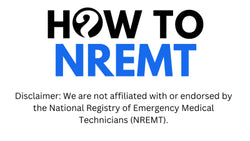Florida's EMS landscape is as dynamic as its weather, from high-stakes urban emergencies in Miami to critical care needs across the vast Everglades. As a dedicated EMS professional in the Sunshine State, staying ahead means understanding the very foundation of your national certification: the National Registry of Emergency Medical Technicians (NREMT) exam. This isn't just about passing a test; it's about validating your readiness for the real-world challenges unique to Florida’s diverse communities.
The NREMT consistently refines its certification examinations to ensure they mirror the evolving demands of emergency medical practice. As of April 7, 2025, the NREMT has introduced modernized content domains and a renewed focus on specific competencies. For Florida's aspiring and current EMS providers, grasping these shifts is paramount for efficient preparation and a confident first-attempt pass.
This comprehensive guide will break down the latest NREMT content domains across all levels (EMT, AEMT, and paramedic), offering clarity on what's now being assessed.
What's New for EMR and EMTs
For Emergency Medical Responders (EMRs) and Emergency Medical Technicians (EMTs), the NREMT's Basic Life Support (BLS) certification examinations underwent significant revisions on April 7, 2025. These updates reflect a comprehensive practice analysis designed to align the examination blueprint more closely with the actual tasks and responsibilities of entry-level EMRs and EMTs in today’s EMS environment.
Here’s a detailed look at the modernized content domains you'll encounter on the updated BLS NREMT cognitive exams:
1. Scene Size-Up and Safety
This domain rigorously evaluates your ability to rapidly and accurately assess an emergency scene. This includes identifying potential hazards (e.g., traffic dangers on I-95, chemical spills, unstable structures after a storm), ensuring the safety of yourself, your crew, and the patient. It extends to initiating an effective action plan and quickly determining the number of patients involved and any additional resources required before initiating direct patient contact.
This initial phase is absolutely foundational for all subsequent actions in an emergency response.
2. Primary Assessment
This critical domain centers on your capacity for swift recognition and immediate management of any immediate life-threatening conditions a patient may be experiencing. It encompasses a systematic evaluation of the patient's airway patency, breathing effectiveness, circulatory status, and level of consciousness (the fundamental ABCs). This methodical approach is vital for quickly establishing the urgency of the patient’s condition and prioritizing immediate, life-sustaining interventions.
This initial patient contact is frequently the most time-sensitive and pivotal moment in the field, demanding rapid and accurate judgment.
3. Secondary Assessment
Following the primary assessment, this domain transitions to a more detailed and systematic examination of the patient. This includes meticulously gathering a comprehensive medical history. You will then perform a thorough physical examination (which might be a head-to-toe assessment for trauma or a focused exam for medical complaints based on the chief complaint).
Finally, you must synthesize this information to identify any underlying medical conditions or injuries that will profoundly influence subsequent patient care and transport decisions.
4. Patient Treatment and Transport
This expansive domain encompasses the full array of interventions an EMT is authorized to provide to the patient. This ranges from managing major body systems experiencing distress (e.g., respiratory emergencies, cardiac events, musculoskeletal injuries, neurological deficits) to the safe and effective administration of approved medications (such as aspirin for suspected cardiac chest pain, oral glucose for hypoglycemia, or assisting with epinephrine autoinjectors for anaphylaxis).
It also includes techniques for controlling life-threatening bleeding, addressing environmental emergencies (like heatstroke or hypothermia common in Florida), and securely preparing the patient for transport to an appropriate medical facility.
5. Operations
This domain addresses broader aspects of EMS operations and professional conduct crucial for functioning effectively within Florida's EMS system. It includes effective communication strategies with dispatch centers, other healthcare providers (e.g., hospital emergency department staff upon arrival), and personnel at the scene (e.g., local fire rescue, law enforcement). It also covers efficient management of medical equipment inventory, accurate and timely documentation of patient care reports (PCRs), and ensuring the ambulance is properly stocked, well-maintained, and ready for immediate response.
Evolution for ALS: AEMT and Paramedic Content Domains

For Advanced Emergency Medical Technicians (AEMTs) and paramedics, the NREMT implemented significant changes to their certification examinations effective July 1, 2024. These updates introduced a single, comprehensive cognitive examination that integrates what was previously assessed across separate cognitive and psychomotor components. The focus shifted heavily towards advanced clinical judgment and application of knowledge in complex scenarios.
Here are the updated content domains for AEMT and paramedic NREMT cognitive examinations:
1. Airway, Respiration & Ventilation
This domain critically assesses your advanced capabilities in managing patient airways. This includes complex techniques for ensuring adequate mechanical ventilation and optimal oxygenation, dealing with both basic and sophisticated airway management strategies for patients across all age groups. Proficiency here is vital for maintaining life-sustaining respiratory function.
2. Cardiology & Resuscitation
This crucial section evaluates your expertise in recognizing and managing a wide array of cardiac emergencies, from acute coronary syndromes to complex arrhythmias. It encompasses advanced understanding and application of cardiopulmonary resuscitation (CPR), automated external defibrillation (AED) usage, and advanced life support interventions tailored for various cardiac arrest scenarios and post-resuscitation care.
3. Trauma
This domain focuses on your ability to assess and manage patients who have sustained traumatic injuries, often involving high-energy mechanisms. It covers initial trauma assessment, hemorrhage control, management of shock, spinal immobilization, and addressing specific injuries to various body regions (e.g., head, chest, abdomen, extremities). Effective and rapid intervention in trauma is paramount.
4. Medical/Obstetrics/Gynecology
This broad domain covers the assessment and management of a vast array of medical emergencies, including but not limited to diabetic emergencies, allergic reactions, strokes, seizures, infectious diseases, and behavioral health crises. It also includes specialized knowledge and interventions related to obstetrical emergencies (e.g., childbirth, complications during pregnancy) and gynecological issues, requiring a comprehensive understanding of diverse patient presentations.
5. EMS Operations
This domain examines your knowledge of broader EMS operational principles, legal considerations, and professional responsibilities. This includes effective communication with dispatch, inter-facility transfers, managing mass casualty incidents, documentation, vehicle operations, and ethical decision-making. It ensures you can function effectively within the larger EMS system.
6. Clinical Judgment
This pivotal domain, with a significant weighting, specifically assesses your ability to integrate information from multiple sources, evaluate patient conditions comprehensively, formulate differential diagnoses, and make sound treatment and transport decisions. It measures your capacity for complex reasoning and problem-solving in dynamic, unfolding clinical scenarios, reflecting the real-world demands of advanced EMS practice.
What These Updates Mean for Your Preparation in Florida
The NREMT's evolution towards these modernized content domains, coupled with the emphasis on cognitive and clinical judgment, signifies a clear message for all aspiring and currently practicing EMS professionals in Florida: preparation must be holistic and application-focused. Simply memorizing facts or relying on outdated study methods is no longer sufficient to guarantee success on these dynamic exams.
For Florida's EMS candidates, this means:
·Shifting Focus to Application: You'll need to demonstrate not just what you know, but how you apply that knowledge in complex, realistic patient scenarios.
·Understanding Weighting: The NREMT provides specific percentages for how each domain is weighted on the exam. Knowing these percentages allows you to strategically allocate your study time, focusing more heavily on areas that carry a greater impact on your overall score.
·Integrated Pediatric Care: The universal integration of pediatric questions across all domains means you can't simply compartmentalize pediatric learning. It must be woven into your understanding of every medical and trauma concept.
·Comprehensive Review: With the NREMT cognitive exam being a computer-adaptive test (CAT) that presents between 70-120 questions for EMTs (110-150 for paramedics), and can conclude early once a passing standard is determined, a truly comprehensive understanding across all content areas is essential. You cannot predict which specific questions or scenarios you will encounter.
The Florida Bureau of EMS often relies on NREMT certification as a direct pathway to state licensure. Therefore, being prepared for these national changes is directly tied to your ability to practice effectively and legally within Florida.
Your Path to Mastering the Evolving NREMT with How To NREMT

The landscape of EMS certification is constantly evolving, mirroring advancements in medical science and the real-world demands placed on emergency professionals. For Florida's dedicated EMTs, AEMTs, and paramedics, understanding these updated NREMT content domains isn't just academic; it's fundamental to your career progression and your ability to provide exceptional patient care.
At How To NREMT, we are acutely aware of these shifts. Our entire preparation system is meticulously built to align with the NREMT's latest standards, ensuring you're not just familiar with the changes, but genuinely prepared to excel. We provide the tools that directly address the critical thinking, clinical judgment, and application-based understanding these new domains demand.
Our programs offer a strategic advantage, combining:
·A 10-Step Study System: Your structured roadmap through the updated content.
·Over 2,000+ Practice Questions: Directly mirroring the new exam style, including TEIs and clinical judgment scenarios.
·AI-Powered Personal Tutor ("Mr. How To"): Instant, adaptive support for any domain-specific query.
·Unlimited Live Coaching: Expert guidance to clarify complex concepts within the new framework.
We believe that with our specialized approach, tailored to the evolving NREMT and your goal of a first-attempt pass, you can confidently navigate these changes and secure your certification.
Ready to master the new NREMT content domains and pass your exam on the FIRST attempt? Get started now!
For intensive, targeted NREMT prep, consider our 7- or 14-Day NREMT Exam Prep Boot Camp via Zoom! The next session runs July 7th-20th, 2025, with limited spots and 50% OFF.

